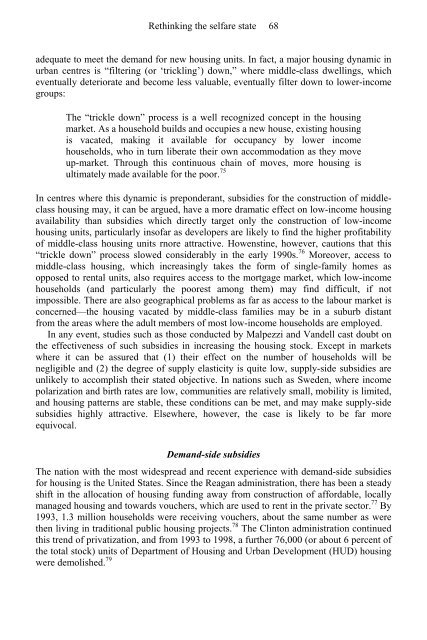Rethinking the Welfare State: The prospects for ... - e-Library
Rethinking the Welfare State: The prospects for ... - e-Library
Rethinking the Welfare State: The prospects for ... - e-Library
Create successful ePaper yourself
Turn your PDF publications into a flip-book with our unique Google optimized e-Paper software.
<strong>Rethinking</strong> <strong>the</strong> selfare state 68<br />
adequate to meet <strong>the</strong> demand <strong>for</strong> new housing units. In fact, a major housing dynamic in<br />
urban centres is “filtering (or ‘trickling’) down,” where middle-class dwellings, which<br />
eventually deteriorate and become less valuable, eventually filter down to lower-income<br />
groups:<br />
<strong>The</strong> “trickle down” process is a well recognized concept in <strong>the</strong> housing<br />
market. As a household builds and occupies a new house, existing housing<br />
is vacated, making it available <strong>for</strong> occupancy by lower income<br />
households, who in turn liberate <strong>the</strong>ir own accommodation as <strong>the</strong>y move<br />
up-market. Through this continuous chain of moves, more housing is<br />
ultimately made available <strong>for</strong> <strong>the</strong> poor. 75<br />
In centres where this dynamic is preponderant, subsidies <strong>for</strong> <strong>the</strong> construction of middleclass<br />
housing may, it can be argued, have a more dramatic effect on low-income housing<br />
availability than subsidies which directly target only <strong>the</strong> construction of low-income<br />
housing units, particularly insofar as developers are likely to find <strong>the</strong> higher profitability<br />
of middle-class housing units rnore attractive. Howenstine, however, cautions that this<br />
“trickle down” process slowed considerably in <strong>the</strong> early 1990s. 76 Moreover, access to<br />
middle-class housing, which increasingly takes <strong>the</strong> <strong>for</strong>m of single-family homes as<br />
opposed to rental units, also requires access to <strong>the</strong> mortgage market, which low-income<br />
households (and particularly <strong>the</strong> poorest among <strong>the</strong>m) may find difficult, if not<br />
impossible. <strong>The</strong>re are also geographical problems as far as access to <strong>the</strong> labour market is<br />
concerned—<strong>the</strong> housing vacated by middle-class families may be in a suburb distant<br />
from <strong>the</strong> areas where <strong>the</strong> adult members of most low-income households are employed.<br />
In any event, studies such as those conducted by Malpezzi and Vandell cast doubt on<br />
<strong>the</strong> effectiveness of such subsidies in increasing <strong>the</strong> housing stock. Except in markets<br />
where it can be assured that (1) <strong>the</strong>ir effect on <strong>the</strong> number of households will be<br />
negligible and (2) <strong>the</strong> degree of supply elasticity is quite low, supply-side subsidies are<br />
unlikely to accomplish <strong>the</strong>ir stated objective. In nations such as Sweden, where income<br />
polarization and birth rates are low, communities are relatively small, mobility is limited,<br />
and housing patterns are stable, <strong>the</strong>se conditions can be met, and may make supply-side<br />
subsidies highly attractive. Elsewhere, however, <strong>the</strong> case is likely to be far more<br />
equivocal.<br />
Demand-side subsidies<br />
<strong>The</strong> nation with <strong>the</strong> most widespread and recent experience with demand-side subsidies<br />
<strong>for</strong> housing is <strong>the</strong> United <strong>State</strong>s. Since <strong>the</strong> Reagan administration, <strong>the</strong>re has been a steady<br />
shift in <strong>the</strong> allocation of housing funding away from construction of af<strong>for</strong>dable, locally<br />
managed housing and towards vouchers, which are used to rent in <strong>the</strong> private sector. 77 By<br />
1993, 1.3 million households were receiving vouchers, about <strong>the</strong> same number as were<br />
<strong>the</strong>n living in traditional public housing projects. 78 <strong>The</strong> Clinton administration continued<br />
this trend of privatization, and from 1993 to 1998, a fur<strong>the</strong>r 76,000 (or about 6 percent of<br />
<strong>the</strong> total stock) units of Department of Housing and Urban Development (HUD) housing<br />
were demolished. 79


